Recirculating aquaculture systems (RASs) are common in production facilities, public aquaria, live market wholesale operations, and retail stores. When properly managed, these systems significantly reduce overall water consumption and improve control of many aspects of culture, including nutrition, water quality, and biosecurity.
This SRAC publication is Part 2 of a three-part “Biosecurity in Aquaculture” series. It should be read after SRAC 4707, Biosecurity in Aquaculture, Part 1: An Overview. Part 2 highlights important aspects of biosecurity in recirculating aquaculture tank systems and provides a practical approach. Although concentrating primarily on finfish, the principles described also hold for other species groups.
Biosecurity in aquaculture consists of practices that minimize the risk of introducing and spreading an infectious disease among the animals at a facility and the risk that diseased animals or infectious agents will leave a facility and spread to other sites and other susceptible species. Good biosecurity also includes reducing stressful conditions that can make fish more susceptible to disease. General biosecurity principles are the same regardless of production system. However, RASs have their own challenges, including different types of system components (e.g., filtration, aeration), system inputs (i.e., water, food, species/density, disinfectant and cleaning chemicals) and disease management, which therefore requires differing biosecurity levels within a single facility.
Types of Recirculating Aquaculture Systems
Recirculating aquaculture systems can be divided into five major types:
- hatchery and growout
- breeding
- long-term holding
- short-term holding
- display
Each system type will have its own biosecurity challenges, and not all of the recommendations described in this publication will be practical or feasible in every situation. Understanding general biosecurity principles, knowing which disease organisms may affect your animals, and determining what your acceptable risk and worst case scenarios are will help you determine which protocols to adopt. The more recommendations you can incorporate, the more biosecure will be the facility and system.
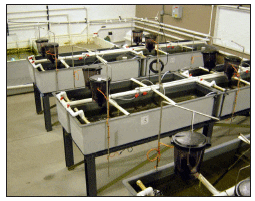
Hatchery and growout systems house younger life stages, which are much more susceptible to infections. Hatchery systems (Fig. 1), which house eggs and newly hatched larvae, and growout systems, which house older fry and fingerlings, require rigorous management of water quality and nutrition. They typically have high stocking densities and must allow for growth, increased size, and higher feeding rates over time. These systems normally house one (or just a few) species per system. High stocking and feeding rates lead to higher levels of ammonia production and dissolved and particulate organics (mucus, skin/scales, feces, uneaten food, carcasses), which can act as pathogen reservoirs. Ornamental aquaculture systems differ from food fish systems in that multiple species are often housed within the same system in separate tanks. This facilitates the movement of disease-causing organisms (pathogens), if they are present, from one group to another.
Breeding systems (Fig. 2) must be designed with specific reproductive size, behaviors, and social structure in mind. Water quality parameters such as temperature, pH, hardness, conductivity and salinity are often manipulated to induce sexual maturation and spawning. Broodstock are the oldest fish in the facility and have more mature immune systems. However, the stresses involved with breeding (including handling and strip spawning for some species) may weaken their immunity. Also, because of their age, broodstock are more likely to develop chronic diseases that will compromise immunity and health. Broodstock are often an important source of pathogens that may be transferred to other life stages. Where possible, older broodstock should be rotated out and replaced with younger stocks to reduce the risk that they will carry disease.
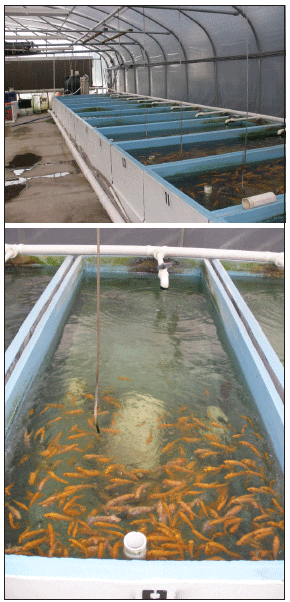
Long-term holding systems, including quarantine systems, are normally designed to house older juveniles, subadults or adults for several weeks to several months. Feeding rates are usually lower than in growout or breeding systems because these fish are no longer growing rapidly. However, proper nutrition and waste management are still major concerns. Quarantine systems, in particular, should be isolated from the rest of the facility because the disease and pathogen status of new fish is unknown. Personnel access to quarantine systems should be limited.
Short-term holding systems are common in pet stores and in live-market retail and wholesale operations. Fish are normally housed for 1 to 21 days. Fish are frequently introduced and removed so that fish numbers fluctuate rapidly over time. Holding tanks and filtration must be able to handle these wide variations. Nutrition is usually less important because of short holding times, although it should not be overlooked. Comprehensive biosecurity procedures in these systems will be the most difficult to adopt. However, many of the recommendations may still be feasible, such as ensuring that individual tanks within a system can be taken off-line and have a separate water source, disinfecting nets and siphon hoses between groups, and making sure that debris and dead fish are removed as often as possible.
Display systems are common in public aquaria, private businesses, and homes (Fig. 3). For these systems, water clarity is a primary concern. It must be managed with appropriate filtration and other means to reduce suspended particulates and discoloration. Multiple species are often housed together and chronic diseases from long-term nutritional or environmental imbalances or from specific pathogens are often of concern.
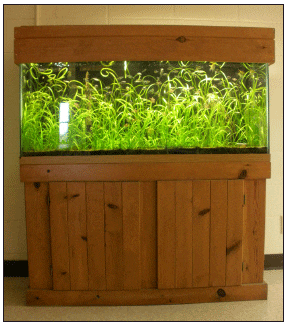
RAS Filtration Components: Biosecurity Considerations
Most RASs contain a mechanical filter that removes solids and a biofilter that transforms ammonia and nitrite into less toxic nitrate; these may be separate components or combined into one unit. Many systems also use a sterilizer- type unit to reduce the numbers of microorganisms that may cause disease, as well as some form of chemical filtration to help balance various compounds in the water. Each of these components can affect biosecurity within the system (Fig. 4).
(Note: This section is intended only to provide some important and relevant biosecurity insights for major RAS filtration components. It is not a comprehensive introduction to RAS design and components. For more information on RAS design and use, see SRAC publications 451, 452 and 453.)
Solids Removal
Solids removal (taking particulates, organic debris, uneaten food, and feces out of the system) is also known as mechanical filtration. It can be accomplished in many ways.
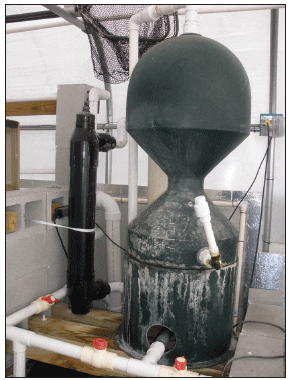
Common devices used for solids removal include bead filters, rapid sand filters, drum filters, canisters, sponges, foam pads, and even undergravel filters. The primary biosecurity concern for these components is that the organics and detritus that build up within them can harbor diseasecausing organisms (bacteria, parasites, fungi, viruses), many of which can then thrive, proliferate and spread throughout the system. Proper maintenance, including regular backwashing and removal of solids, will help reduce this bioload and minimize risk. If a disease outbreak occurs, these components must be properly disinfected or else they can act as a reservoir for future infections.
Because some debris often remains on the bottoms of tanks and sumps (Fig. 5), siphon hoses are often used to remove these organics. However, siphon hoses can also spread disease-causing organisms from one tank to another or one system to another. Appropriate disinfection (see SRAC publication 4707) between uses will help reduce that risk.
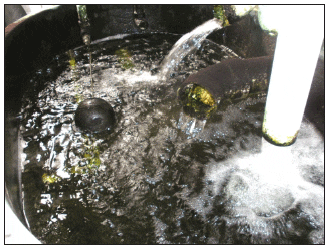
Biological Filtration
Biofilters contain nitrifying bacteria—the “good” bacteria that transform ammonia and nitrite into less toxic nitrate. When starting up a new RAS, most aquaculturists want to speed up the cycling of the biofilter. This normally involves using biofilter media from a previously established system, buying biofilter bacteria from a reputable source, or adding a few hardy “starter” fish over time. Media from another system or hardy fish of a different species and group can introduce disease-causing organisms. There are some other options that may pose less risk. You can set up a smaller container or system with biomedia and feed a low level of straight, household ammonia with no additives (about 3 ppm). This must be done well before the RAS is completed for start up. Once established, with periodic cleaning, this “clean” source of bacteria can be used after systems have been disinfected. Another option is to use a commercial biofilter bacteria product from a reputable source. If you have decided to use “starter” fish for the system, a subgroup of those fish should first be sampled for any pathogens that they may have before they are placed in the system.
Another concern is management in the event of a disease outbreak. Nitrifying bacteria often end up with disease-causing bacteria (as well as parasites, fungi and viruses) as neighbors. These pathogens can also survive within the biofilm (the “slime layer” on the media). If a disease outbreak occurs, the biofilter must be cleaned and disinfected so it cannot serve as a pathogen reservoir.
Chemical Filtration
Chemical filter media is used to change the concentration of specific ions or compounds in the water (e.g., ion-exchange resins such as those used in softeners to remove calcium or zeolite to bind ammonia). It can also build up with debris and act as a mechanical filter (and harbor pathogens) if not properly managed (backwashing and/or media replacement).
RAS Water Sterilization
Ultraviolet (UV) units and ozone are “sterilization” components that can be used “in-line” (as part of the circuit, or a side stream loop off the circuit) to kill microorganisms in the RAS water. (For more information, see SRAC publication 4707). UV sterilizers are sized according to a specific “zap dose” (UV exposure level in ?W• sec/cm2). The actual zap dose to be delivered is determined by the intensity or wattage of the lamp, contact time or flow rate of the water, water clarity, and size and biological characteristics of the target organisms. Ozone (O3) is a highly reactive compound that is produced by an ozone generator and then allowed to contact system water (in a side loop off the main system loop) at a given concentration and for a given time period. Ozone at the proper dose will break apart microorganisms, but it is highly toxic and must be removed from the water before the water returns to the system. Activated carbon is one method of removing residual ozone. Ozone gas also can be hazardous to human health.
A common and potentially dangerous misconception is that UV or ozone sterilization will eliminate all or most disease organisms in the system, making quarantine or the disinfection of equipment unnecessary. If properly sized and maintained, these units can help reduce the total numbers of specifically targeted microorganisms, but only in water that circulates directly through these units. Water that splashes from one system or tank to another, or that is transported by net, siphon hose, or hand from one to another, will not be treated. Also, many pathogens (such as vibrios and mycobacteria) can be found in biofilms or stay in the substrate or water in a tank. These organisms will not be killed because they do not enter the sterilizing units.
Proper maintenance is crucial to proper function. Both UV and ozone units must be maintained according to the manufacturer’s instructions. UV sterilizers often contain quartz sleeves that require periodic cleaning. Bulbs should be changed as specified. Ozone units require even more monitoring and care; any ozone that is not removed from treated water before it returns to the system will be toxic to the fish.
Designing an RAS to Optimize Biosecurity
Recirculating aquaculture systems differ in function, size, filtration, target species, and stocking rates. Before construction, consult an aquacultural engineer, production specialist, and fish health professional for recommendations on building and system design features that facilitate biosecurity. Some of these features add up-front costs, but will, like insurance, pay for themselves over time. Consider the following when designing a system.
Environmental Controls
Temperatures should be optimized for the species in culture. Various design options may be available for the type of surrounding building or cover structure (concrete block or plastic). Another consideration is water vs. air temperature control; items such as heat pumps, swamp coolers, fans, and shade cloth for greenhouses may be selected. Lighting and airflow also should be considered as part of the design. If source water is unprotected (i.e., may contain disease-causing organisms or carrier fish) and requires disinfection, the use of ozone or UV sterilization or chemical sterilization (i.e., chlorination) should be considered and discussed with the appropriate professionals.
Foot Traffic Patterns
Foot traffic patterns within and between buildings and systems should be minimized to reduce the potential for cross-contamination from one system or one biosecurity zone/level to another. Traffic should flow from areas with the most susceptible and “cleanest” life stages (eggs, larvae, younger life stages) to the least susceptible and “dirtiest” (sub-adults, adults, potential carriers). Animals in quarantine should be physically isolated and located away from the main traffic areas. Barriers such as fencing, closed doors, and appropriate signage (e.g., “authorized personnel only,” “broodstock,” “growout”) will help remind employees and inform visitors, thereby reducing the risk (Fig. 6).
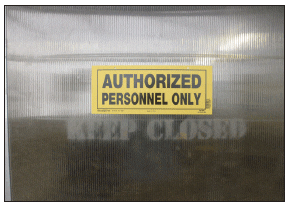
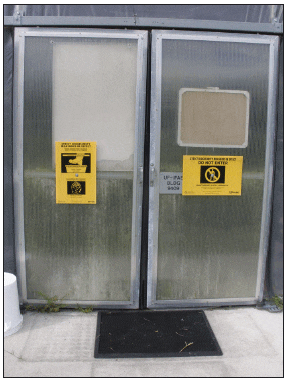
Disinfection stations (footbaths, hand washing stations, showers) should be placed at all entrances to the facility and individual buildings, as well as between systems and areas with different biosecurity levels (Fig. 7; also see SRAC publication 4707). Additional cleaning stations (for vehicles and humans) should be available as needed.
Tanks and Filtration
Tanks and filters should be of the proper size and shape for the species, life stage, and density. Water turnover and flow patterns also should be designed for the specific species. Ideally, flow and tank design should aid in the removal of solid particulates. For example, there should be a slight slope toward the central drain with circular flow toward the center drain in circular tanks.
Isolation and Separation
Systems should be housed in a secure structure that protects them from the weather and that keeps out dirt, unprotected water, and pests such as rodents, insects and feral cats that can carry or spread disease.
Buildings, systems and zones within the same structure should be physically separated (distance, walls) and designed to isolate animals that differ in disease susceptibility and in their potential to be disease reservoirs or carriers. As discussed earlier, older animals such as broodstock are more likely to be clinically healthy carriers than younger animals. Fish of unknown disease status, including those in quarantine or that have come from outside sources, should be isolated in a completely separate building with appropriate disinfection stations.
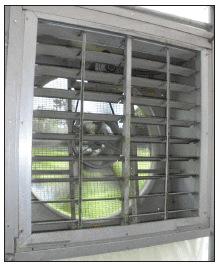
Individual tanks or vats within a system should be plumbed to allow them to be taken off-line and isolated, should there be a disease outbreak. This can be achieved by plumbing in an extra set of inflow and outflow lines to allow conversion to a flow-through or static system. Where feasible, using individual covers will further reduce diseases spread by the aerosolization of bubbles. If covers are not possible, steps should be taken to minimize aerosolization (Fig. 8) and other ways diseases are spread. This might include having wider physical separation between tanks or systems; redirecting airflow; using additional, clearly marked and dedicated equipment (Fig. 9) for diseased tanks or systems; and being even more vigilant about using disinfection stations for equipment and people moving between systems. Equipment (such as nets and siphon hoses) should be hung and kept off the floor—which should always be considered “dirty” (Fig. 10).
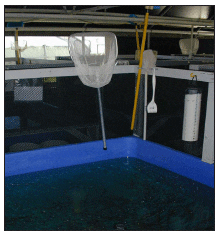
Any dead or moribund (very sick) fish are reservoirs of disease organisms and should be removed and disposed of according to regulations to minimize the spread of disease to other fish in the facility.
Any discharge or wastes from systems housing diseased animals should flow into a sequestered area for appropriate disinfection, especially if the disease could spread and cause significant mortality, if normal discharge would be to an area that connects to a natural water body, and/or if the disease is reportable.
Using multiple systems (vs. one large system) and redundant components (filtration, pumps)—or at least having back-up equipment available—are additional design features to incorporate, although costs can make this a challenge. Multiple systems and component redundancy will also allow for more thorough, periodic cleaning without completely shutting down production and will help to isolate outbreaks to smaller units, thus reducing the risk of facility-wide problems.
Another isolated “clean” area should be set up to house units mentioned earlier that contain seasoned biofiltration media (that are being maintained by adding about 3 ppm ammonia with no additives) for use in case a system needs to be disinfected completely. This active, nitrifying bacteria media will significantly reduce start-up time.
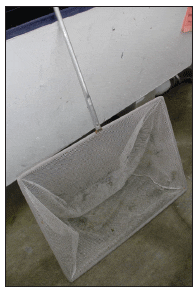
Cleaning and Disinfection
General RAS maintenance should include removing organic wastes and other debris from the system. Tank shape and water flow should be designed to facilitate the movement of solid particulate wastes from the unit. For recirculating system water, UV sterilization or ozone may be warranted, depending upon the biosecurity risks and potential for spread within a given system. Appropriate UV zap doses and ozone concentrations should be determined in consultation with an aquacultural engineer and fish health professional, and should be based on specific pathogens and system water parameters.
Tanks and equipment, including all filter components, should be easily cleaned or backwashed both during use and when a complete disinfection is necessary. Surfaces must be scrubbed to remove biofilms that can harbor pathogens. Inflow and outflow water lines should be designed to permit periodic flushing (this can be done with removable end caps or end valves) to remove accumulated debris. All areas in and around the system and filtration components should be easily accessible and should be designed so that there are no areas that might harbor pathogens (such as low spots in the floor or back corners that may accumulate detritus or dead fish). If such areas do exist, they should be cleaned periodically (open floor drains should be flushed or bleached, for example).
Disinfection equipment and supplies (including those at disinfection stations, nets, containers) should be easily accessible. (For more information on disinfection methods see SRAC publication 4707).
Developing a Biosecurity Plan for Your RAS
A recirculating aquaculture system facility’s biosecurity plan is based on a number of factors, including culture species, pathogens of concern, water source, production scheme, system and building configuration, and other facility-specific biosecurity concerns. Use the following guidelines to develop a biosecurity plan for your operation. Part 1 of this series (SRAC publication 4707) has background information and a more general biosecurity plan template.
Major biosecurity problems can occur when:
- a system has not been managed properly and there are water quality problems that stress the fish;
- new fish entering a facility are not quarantined properly;
- one system has multiple functions and houses multiple age classes;
- an outbreak is not immediately contained within a given unit or system; or
- adjacent systems house different age classes or species and no protocols to prevent cross-contamination are in place.
Because of differences in management, the immune status of fish, and potential pathogen loads (from the environment or fish) among functional units, age classes or system functions should not be mixed and physical barriers between systems should be erected.
Work with knowledgeable professionals. When planning for biosecurity, consult with an experienced aquaculture health professional, production specialist, and aquacultural engineer.
Know your species. Species’ needs (water quality, environment, nutrition) should be reflected in system and facility design and overall husbandry protocols. Additional biosecurity measures will be much less effective if system design and husbandry are suboptimal. Relevant considerations include tank shape, color, and depth; water flow patterns and rates; lighting; and feeding requirements.
Know your pathogens. Prioritize major and minor pathogens of concern and identify the critical control points in your operation where they may enter. Recirculating aquaculture systems favor the growth and spread of disease-causing organisms for many reasons—lack of natural competitors or a more natural ecology that would be seen in ponds; build-up of organics and potential disease reservoirs in filters, pipework, sumps, and biofilms; minimal flushing or dilution; higher fish densities; and greater potential for other underlying stressors. For example, several important bacterial pathogens seen in tilapia recirculating aquaculture systems include Streptococcus, Francisella and mycobacteria. All three are environmental bacteria and can be found in the water and/or biofilms. Biofilms can be a problem when trying to disinfect for mycobacteria, especially since biofilms and debris in pipes are not easily reached for scrubbing and biofilms can protect pathogens from chemical disinfection.
Understand your critical control points. Be aware of how pathogens enter and spread through the facility and assess your risks.
- Source of aquacultured species and preventive management. Know your supplier, ask questions about previous disease issues, and, ideally, purchase fish from a supplier who practices the highest level of fish health management and who provides a health certificate with the shipment. Even a small number of pathogens on the fish will be amplified in an RAS. Determine which pathogens are of concern and work with a fish health professional. If necessary, sample fish for specific diseases before they enter the facility or during quarantine. Additional preventive measures may be necessary, such as egg disinfection, vaccination, and the use of immunostimulants. If the fish are produced on site there should be physical separation and disinfection stations between the breeding area, the fry/ fingerling area, and the growout area.
- Water source. Protected water sources, such as deep wells, have a much lower risk of containing disease-causing organisms than unprotected water sources such as surface water that contains fish and other animals. If the sole water source is unprotected, sterilization with UV or ozone or chlorination (bleach) followed by neutralization may be necessary. Although still a fairly new concept in RAS, adding probiotic bacteria may help establish a more “balanced” system where “good” bacteria may out- compete the “bad” disease-causing bacteria. More research is needed.
- Other critical control points. Consider risks from feed. Use high quality feed and store it in a cool, dry place (or as directed by the manufacturer); improperly stored feed will lose nutritional value and can harbor disease-causing bacteria and fungi. Live and frozen foods can carry parasites, bacteria, fungi, and viruses (many of which survive freezing). Various measures can be taken to minimize some, but not all, risks from these (see SRAC publication 4707). Animals (dogs, cats, birds, reptiles, rodents, insects, aquatic invertebrates) can transfer pathogens from one system to another or may contain life stages that can infect fish as part of the life cycle. Aerosolization (movement of very small particles through the air in very fine water droplets or bubbles) can spread organisms from the outside to the system, or from tank to tank.
- Human risks. Consider risks from personnel and visitors. People can easily spread disease-causing organisms on their shoes, hands and arms by touching water, animals or equipment in one system and failing to disinfect themselves before handling fish, water or equipment in another system.
Design the systems and facility to physically isolate groups of fish and exclude pathogens.
- Individual systems should be age class and species appropriate and specific. They should be easy to clean or designed to facilitate self-cleaning.
- Where possible, having multiple, separate systems is better than using one large system for each age class. This reduces the risk of large outbreaks and the potential for losses from disease or mandatory depopulation. Each system (or group of systems) should have dedicated equipment and disinfection stations. Keep nets, siphons and other equipment off the floor.
- Quarantine systems for new fish or sick fish should be self-contained and physically isolated. Ideally, the “all-in-all-out” protocol should be used (see SRAC publication 4707).
- Be sure to separate species, age classes, and animals of unknown vs. known disease or pathogen status. Eggs, larvae and juveniles will be the most susceptible to infection (in that order). They should be housed in separate groups and should be completely isolated from sub-adults and broodstock. Animals of different disease status also should be physically separated.
- UV or ozone sterilization can help reduce pathogen loads and disease spread, but with the limitations discussed earlier. Individual tanks within a system should be built to allow for self-containment and isolation, in case of disease outbreaks.
Control animal movement and personnel and visitor flow patterns.
- The facility should be designed so that production flow patterns (movement of fish groups) and human foot paths from one life-stage system to the next reduce the potential for contamination.
- Ideally, employees should work only with specific age classes. If that is not possible, then work with “cleaner” or more vulnerable animals (eggs, fry, fingerlings) first, and then with animals that have a stronger immune system and/or that are “dirtier” (older, quarantined, sick) at the end of the day.
- Footbaths, hand washing stations and showers should be clearly visible and easy to use.
- Have concise, clear rules for personnel and visitors regarding area access and the receiving locations for supplies, materials, etc. Signs can help clarify these rules and designate areas that are off-limits or more biosecure.
Manage employees and people.
- Standard operating procedures (SOPs) for biosecurity. These should be developed and easily accessible, along with material safety data sheets (MSDS), emergency contact numbers, and other relevant work documents.
- Personnel. Employees should be formally trained on the importance of biosecurity, SOPs, and compliance; training should be given regularly. Personnel should have the opportunity to provide constructive comments to improve SOPs.
- Visitors. Because visitors can unknowingly introduce pathogens, strict guidelines for visitor access should be developed, especially to quarantine and sensitive areas. These rules should be easy to understand. Vehicular access also should be restricted.
Plan for disinfection, sanitation, and the disposal of dead fish.
- Methods. It is important to do a general cleaning (scrubbing to remove organics and soils) before disinfecting. Physical and chemical disinfection methods are specific to types of equipment and areas. There should be regularly scheduled cleaning and system maintenance. Cleaning equipment and supplies should be stored in specific areas, with separate storage for chemicals.
- Disposal. Remove dead and very sick fish at least once or twice a day. Understand local, state and federal regulations for handling disease outbreaks, disposing of fish killed by reportable vs. nonreportable diseases, and for discharging water from sick populations.
Routine health and disease testing. Routine observation and disease sampling of all populations in the facility will serve as an early warning system.
- Quarantine protocols. Quarantining new animals is important to reduce the risk of introducing a disease into an established RAS. Water used should be from protected sources. Initial and routine sampling of new, incoming animals should help identify common diseases and specific diseases of concern. Samples should be taken at the beginning of quarantine and then periodically throughout. The length of time for quarantine will depend upon the diseases of concern, the species, and what the animals will be used for. For future broodstock, an ideal quarantine period is 30 to 60 days.
- Routine observations. It is important to observe fish for response to feeding, behavioral changes, position in the water column, changes in physical appearance (fins, darkening, bloody areas), exophthalmia (pop-eye), bloating, scale loss, increased mucus in the system, masses, and grossly visible parasites. These may indicate a potential disease problem.
- Routine sampling. Throughout the production cycle, routine sampling of fish by a fish health professional will reveal any potential problems that may be developing before a full-scale disease outbreak occurs. This information can then be used to modify the biosecurity plan.
Disease outbreaks and mortalities. Develop a contingency plan for disease outbreaks and mortalities.
- Isolation and separation. Although important as a routine, this becomes even more critical in the event of an outbreak, since diseases can spread very rapidly within a system. Diseased populations should be isolated. All employees should be alerted and appropriate signage or other means used to indicate which group(s) is affected.
- Problem solving. Before a facility begins operating, discuss these issues with a fish health professional and fish disease diagnostic laboratory: system water quality, nutrition, protocols for sampling fish (numbers of animals, what tests should be run, how to ship, who to contact for results). Also set up a system for testing samples of live or frozen foods.
- Cause(s). What is/are the diagnosed cause of the outbreak? The following factors should all be taken into consideration: pathogen(s), husbandry-associated factors, level of risk, most probable route of entry, and reportability.
- Management. Pull dead animals from the system at least once or twice (ideally several times) per day. Determine if any husbandry changes are also necessary. Establish a chain of contacts, including a fish health professional, facility health manager, facility area managers, and relevant regulatory authorities, to determine options, drug legalities and availability, routes of administration, personnel and supply requirements, reporting to proper authorities if required, cost/benefit for various management decisions, and prevention.
- Depopulation and disposal. Determine appropriate methods of depopulation, carcass collection, disposal, and disinfection.
Records are critical for all areas of production, system and health management.
- General production. General production records such as broodstock fecundity, growth rates for younger life stages, numbers stocked, stocking weights, etc. are ways of tracking groups and can be used to assess the effectiveness of a biosecurity plan.
- Biosecurity management. Documentation (check lists) will help ensure that employees fulfill assigned tasks (such as changing net dips and footbaths), carry out system and equipment checks, document feeding and observations, and remove dead and very sick fish, and that visitors are tracked and are aware of biosecurity policies. A biosecurity audit (overall review of biosecurity at the facility) by an aquatic animal health professional will help ensure that adequate precautions are being taken. During a disease outbreak, procedures and records should demonstrate to authorities that good biosecurity measures were in place, that affected groups were isolated, and that no cross-contamination with other groups occurred.
- Health and disease management. Records should also document morbidity and mortality numbers, disease signs, feeding response and other general health observations, and water quality/chemistry. For diagnostic sampling, records should include sampling done by group, date sampled, numbers sampled, diagnostics run, findings, treatments and amounts of drugs used, veterinary prescriptions if required, and, finally, methods of collecting and disposing of diseased or dead animals.
Summary
Recirculating aquaculture systems have their own unique biosecurity challenges, and good system design can help minimize these. Examining specific points in production when pathogens may be introduced or disease may develop will help in creating a solid, workable biosecurity plan. Good biosecurity minimizes exposure and susceptibility to pathogens and reduces economic losses from mortalities, as well as losses resulting from mandatory depopulation.
Biosecurity program development for an RAS facility should begin at the planning and design stage. Get help from an aquacultural engineer, a production specialist, and an aquatic animal health professional when developing your plan. Important considerations include animal and water source, species and life stage requirements, health management, intended use and system capacity, economics, personnel, overall husbandry management, and logistics. Don’t wait until a major catastrophe has occurred. Low level losses, over time, will also reduce revenues and can be avoided with a good plan.
Acknowledgements
Thanks to Kathleen Hartman for her comments and to the anonymous SRAC reviewers who also provided excellent suggestions.


